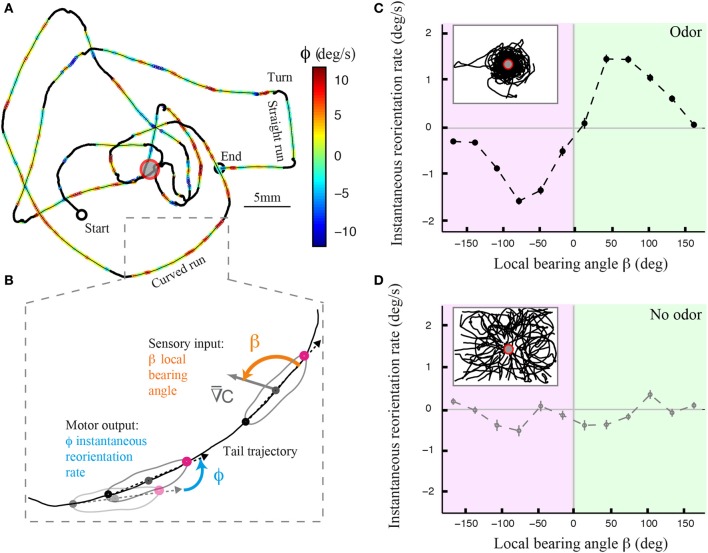Figure 1.
Directional modulation of runs in Drosophila larval chemotaxis. (A) Illustrative trajectory of a larva navigating near an odor source (red ring). The trajectory can be decomposed into turns (black), straight runs, and curved runs. Runs are color-coded based on the larva's reorientation rate or instantaneous change in orientation (see Materials and Methods). Yellow-to-red color range denotes counterclockwise rotations as the animal progresses forward. Green-to-blue denotes clockwise rotations. (B) Close-up view of a curved run trajectory (tail position) where the instantaneous reorientation rate (ϕ) and local bearing angle to the stimulus (β) are visually illustrated. The relationship between these two variables allows us to determine the contribution of weathervaning to the reorientation process. (C) Dependency of the averaged reorientation rate on the local bearing angle for wild type larvae tested in the presence of a sensory gradient created by an odor droplet of 30 mM ethyl butyrate. Inset shows a superposition of 42 trajectories of wild-type larvae. The reorientation bias is maximum when the sensory gradient is lateral to the animal and it is correlated with the direction of the stimulus. The bias decays to zero when the gradient is parallel to the animal, either facing up the gradient or down the gradient. The bearing angle values are represented in 12 bins of 30°. (D) Same plot as in (C) for wild type larvae (N = 17) tested in the absence of odor, where the fictive local bearing angle is computed based on the odor landscape used in (C). The absence of directional modulation establishes that the correlation between reorientation rate and local bearing is due to the odor gradient and that it does not result from the geometry of the arena. In (C,D), the average reorientation rates are calculated from bins including between Nmin = 1096 and Nmax = 6448 data points.

